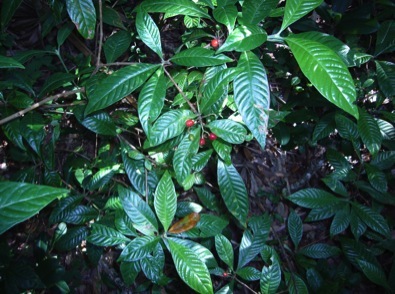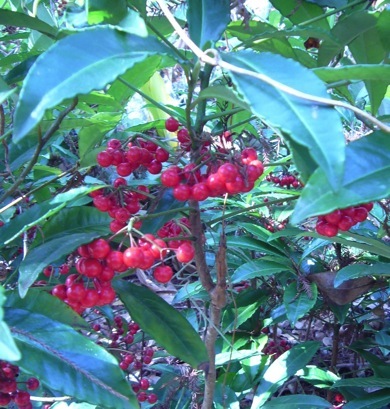
Wild Coffee is usually found on the coast
Psychotria nervosa Florida Style
Because I am constantly asked about it: Yes, you can eat the pulp off the seeds of the wild coffee, and yes, you can make a brew from the seeds. That’s the good news. Now the bad news:
The pulp lacks character. Let’s call it bland with a musty aftertaste, but edible. Some detect a hint of sweetness. As for using the seeds as coffee: Not a good idea but don’t take my words for it. Professor Daniel Austin, author of Florida Ethnobotany, says the brew tastes bad and can leave you with a headache. I would add they also do not have any caffein. If caffein is what you seek, read my article on hollies.
A native of Florida, the wild coffee bush, Psychotria nervosa, (psy-KO-tri-a ner-VO-suh) has red berries from about December to March. It attracts cardinals, mockingbirds, catbirds and spicebush swallowtail butterflies. The attractive plant is easily identified by shiny beautiful evergreen foliage and the bright red berries. Prominent veins give the plant a textured look. You’ll find it on hammocks, barrier islands and in landscaping. Wild coffee likes filtered sunlight and living under cabbage palms and scrub oaks.
While “Wild Coffee” contains no caffein some members of the family are hallucinogenic. The roots can be used like ipecac to induce vomiting. One relative found in warmer climates, Psychotria lingustrifolia, the Bahama Wild Coffee, has edible pulp as well.
It is fairly easy to tell you have a wild coffee plant, but which one is a bit more of a challenge. Psychotria nervosa is an erect, evergreen, branching shrub to 10 feet, smooth to sometimes hairy leaves, sometimes hairy stems. Leaves opposite, simple, no teeth, shiny green above, elliptical to oval, 2.5 to 6 inches long, two inches wide. Flowers white to eight inch, tubular with four or five lobes, stemless clusters, where the upper leaf stems meet the main stem, blossoming usually in spring and summer. Its sessile flower clusters (stemless) is one of two Psychotrias like that, the other is the P. sulzneri but the sulzneri has greenish-white flowers and upper surface of its leaves are dull green/blue and not shiny. It is always hairy. P. lingustrifolia has skinny leaves and long stalked flower clusters. P. punctata has stalked flowers like the lingustrifolia but has dots under leaves.
To recap: If the leaves have dots on the bottom it is a punctata. If it has long-stalked flowers/berries and no dots it is the lingustrifolia. If it has non-shiny leaves it is the sulzneri. If it has shiny leaves, short or stalkless white flowers/red berries and no dots, it is the nervosa. See below for a similar looking non-edible plant.
Psychotria means having medical applications, nervosa means conspicuous veins. Lingustrifolia is tongue like leaves, punctata is dotted, and sulzneri... that’s anyone’s guess but there was a C.F. Sulzner in Miami who was involved with helping the New York Botanical Society about a century ago. P. nervosa also used to be called Suzlner’s Coffee.
Green Deane’s “Itemized” Plant Profile
IDENTIFICATION: Psychotria nervosa is an erect, evergreen, branching shrub to 10 feet, smooth to sometimes hairy leaves, sometimes hair stems. Leaves opposite, simple, no teeth, shiny green above, elliptical to oval, 2.5 to 6 inches long, two inches wide. Flowers white to eight inch, tubular with four or five lobes, stemless clusters, where the upper leaf stems meet the main stem
TIME OF YEAR: Blossoming usually in spring and summer, fruits in winter.
ENVIRONMENT: Shady areas moist and well-drained to moist but not water logged; hammocks, barrier island.
METHOD OF PREPARATION: Flesh of the seed is edible raw, seeds can be roasted and ground for a black drink that may give you a headache.

Coralberry’s an invasive from Asia. Note its veins are not as prominent as Wild Coffee and the edges are crenate, resembling blunt teeth.
Don’t confuse the Wild Coffee with the Ardisia crenata, or coralberry. Note the leaves of this ardisia are scalloped, like blunted teeth. The Wild Coffee leaf edges are smooth, also called “entire.” (Kre-NAY-tuh means scalloped.) I have eaten the pulp off one berry and suffered no ill effects that I know of.

